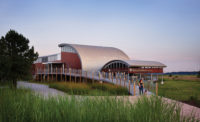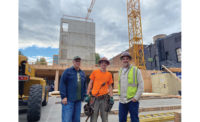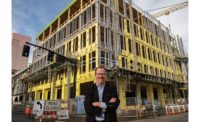Related Article:
Prometheus 'Bio-cement' Touted as Portland Cement Sub
Back to:
25 Top Newsmakers
Wil V. Srubar III is the common denominator for cotton, cattle, the Houston Astros, the Dept. of Defense, micro algae and Prometheus Materials. If he had not grown up on a cotton farm-cattle ranch, he might never have become interested in saving the planet through biology-based building materials. And if his father had not taken young Wil off the family farm to Houston to watch the Astros play baseball, he might never have been awestruck by the Astrodome and motivated to become a structural engineer. If Srubar hadn’t become a structural engineer and bio-materials scientist running a laboratory at the University of Colorado, he would never have received a $2-million DOD grant to develop his pride-and-joy bio-block—masonry units made from micro algae-based “biocement” instead of portland cement. And were it not for all that, Prometheus Materials, which Srubar co-founded, would not have been created to produce the block.

Algae-produced block is the first concrete example of Srubar’s drive toward blurring boundaries between constructed and natural worlds.
Photo courtesy Prometheus Materials
“My purpose is to try to blur the boundaries between the built environment and the natural world,” says Srubar, Prometheus’ chief technology advisor, an associate professor of materials science engineering in the Dept. of Civil, Environmental and Architectural Engineering at the University of Colorado Boulder and lead principal investigator of the CU team that invented the biocement.
The block’s secret juice is a hydrogel-based living building material containing bacteria capable of microbially induced calcium-carbonate precipitation. The biological binding agent replaces all the portland cement in conventional block, reducing its embodied carbon by 90%, says Prometheus.
“This is a radical departure from standard concrete production,” says Srubar. By eliminating portland cement, “we are curing the source of the problem with concrete, not the symptoms,” he adds.
The product is the brainchild of Srubar and three other principal investigators of the research, all of whom also are co-founders of Prometheus. The other co-inventors are Mija Hubler, Sherri M. Cook and Jeffrey C. Cameron.
“The path Wil and his team are on is certainly one of the most promising,” says Chris Magwood, manager of the Rocky Mountain Institute, which focuses on the environment and green energy. “A lot of work in that space is still theoretical.”
Production of the blocks will begin as soon as Prometheus receives certification from ASTM, likely by the end of March, says Loren Burnett, co-founder, president and CEO of Prometheus. “Wil’s super-smart and very entrepreneurial,” adds Burnett. “He’s likeable and easy to work with.”
Though the block is farthest along in commercial development, Srubar’s lab has other living building material products in the pipeline. One is transparent wood for replacing silica glass in buildings. Another is the use of biomimetic antifreeze polymers for improved freeze-thaw resistance of concrete. A third is using algae-grown biominerals, such as diatom biosilica, in concrete as a supplementary cementitious material. Two more are bio-based superabsorbent polymers from seaweed for reducing autogenous shrinkage in concrete and biopolymer replacements for asphalt materials.
The lab is also growing carbon-negative limestone using coccolithophore algae for carbon-negative portland cement. The team—which includes the National Renewable Energy Laboratory, the University of North Carolina Wilmington and Minus Materials—just landed a $3.2-million grant to commercialize the technology. Srubar is a co-founder, former CEO and chief technology officer of Minus.
There are more projects, such as 3D-printed earth materials and structures, “but this list captures most of them,” says Srubar.






Post a comment to this article
Report Abusive Comment